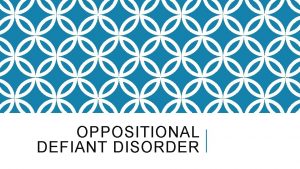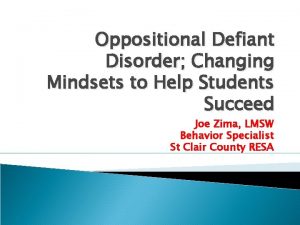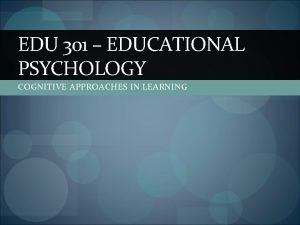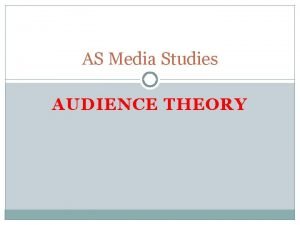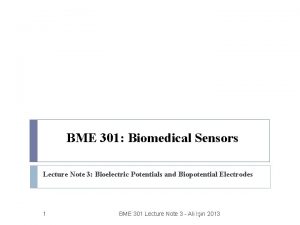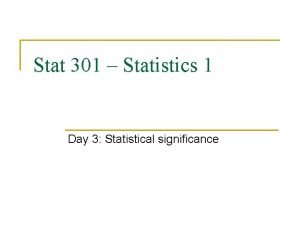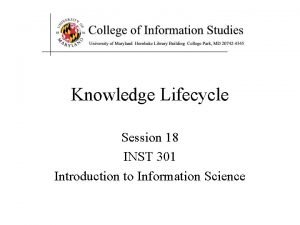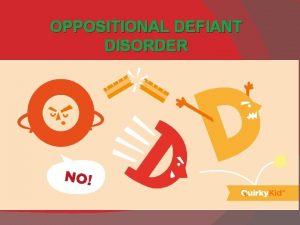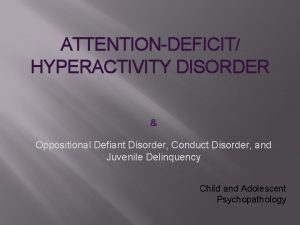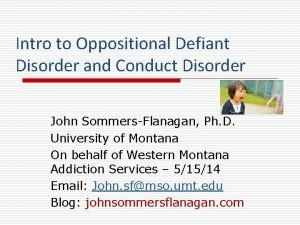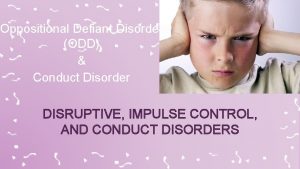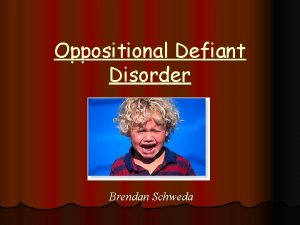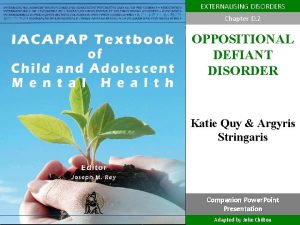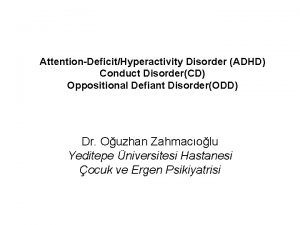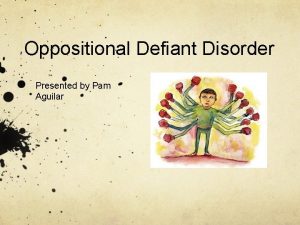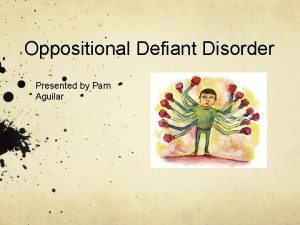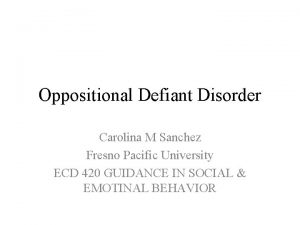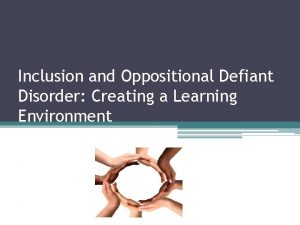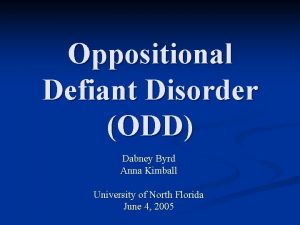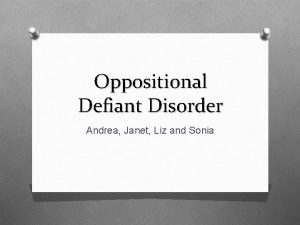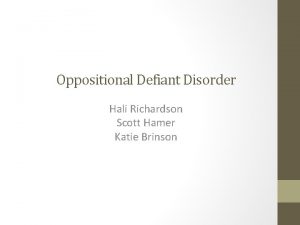EDU 301 Lecture 17 Oppositional Defiant Disorder O






















- Slides: 22

EDU 301 Lecture 17

Oppositional Defiant Disorder O Remember O May be linked to deficits in learning behavior (pre-K training leads to better adolescents) O May be linked to deficits in school readiness (more common in boys, not skilled in basic manners like sitting, listening, sharing) O May be linked to deficits in teaching strategies

Interventions for ODD O Attention seekers need a replacement O O behavior Use positive reinforcement to teach acceptable behaviors Early intervention to prevent alienation Avoid teacher pitfalls by taking notice of good behaviors at an equal or greater rate School-wide classroom rules: what goes in one class goes throughout the school: kind of like a zero tolerance rule

The key O Positive reinforcement to invoke acceptable behaviors

Non-compliance- “It’s time to put up your artwork for the day. ” OPassive non- compliance ODirect defiance OSimple refusal ONegotiation

Causes of non-compliant behavior O Inconsistent adult direction O Adults who are stubborn and unlikely to change their behavior to better meet the needs of the students (maybe noncompliance is more like resentment? ) O Never learned compliance at home

Interventions for noncompliant behavior O Find out where the power struggle is and try to O O diminish Teach compliance---who else will if you don’t? Use behavior momentum by asking a high frequency of high probability compliance requests and then imbed a request that has historically caused non-compliant behaviors Remember the negotiator? Listen Linda

Aggressive Behavior O Most serious of inappropriate behaviors O Gaining power O Escape O Self-gratification O Hitting/pushing O Isolating a peer on purpose O Name-calling O Sexual assault O Homicide

2 classifications Physical O Kicking O Hitting O Spitting O Biting O Grabbing O Throwing Verbal O Bossy behavior O Teasing O Tattling O Criticizing others O Picking on others O Sarcastic comments

Common denominatordegrading or harming another human being. O The aggressor is seeking power O The aggressor has little regard for fellow classmates O The aggressor is seeking self gratification

5 patterns of aggression O 1. Overaroused aggression-high level of activity which causes multiple accidents; lots of random pushing and shoving of anyone and everyone. There is no specific target. O 2. Impulsive aggression-student is generally quiet until he/she becomes frustrated, at which point will explode in emotion and possible violence

5 patterns con’t O 3. Affective aggression-Student exhibits rageful aggression. They are seen as chronically angry, resentful and hostile O 4. Predatory aggression-Student is seeking revenge, waiting for a chance to get back at another person in a harmful way O 5. Instrumental aggression-Student is intimidating and a bully; he/she gets their way by intimidation

Common causes O Can be intergenerational O From within the family: O Lack of emotional support O Exposure to domestic (and other) violence O Corporal punishment O High level of family conflict, unresolved

Child is trained to be aggressive O May receive positive reinforcement for the behavior through laughter and attention O May get out of ‘work’ through aggression O Aggression is learned in early childhood O Social isolation more aggressive behavior

Modeled by adults or peers O We learn to deal with frustration by watching others O If a child only witnesses aggression to frustration what can we expect? O Teachers thus have to be the model O Stay calm, talk through it, walk away until calm

Media Influence O Exposure to constant media violence desensitizes the child O Studies show media violence is linked to aggressive behavior in children (see handout for cited study) O A study of 8 year olds showed that media was best predictor of aggressive behavior in 18 year olds (See handout for citation)

Social Skills deficits O Typical scene: An aggressive child pushes his/her way into an activity. O Students respond by going elsewhere or stopping the activity O Student is rejected, but finds other peers who may be more accepting O These ‘new friends’ encourage aggression leading to long term social problems in society

Interventions O Teach acceptable skills through positive reinforcement (more chocolate? ? ) O Develop the following in the student: O Self awareness O Think about personal feelings to peer reactions O Think about solutions O Recognize when he/she is beginning to feel angry O Talk yourself through it

Other interventions O More positive/less negative O Behavior contracts O Token economies O Building relationships (“I noticed…”) O Meaningful curriculum (differentiated instruction)

ADHD O https: //www. youtube. com/watch? v=u. U 6 o 2 _UFSEY

Don’t give up on Bobby O https: //www. youtube. com/watch? v=p. JFAU Autx. BA

ADHD TED TAlk O https: //www. youtube. com/watch? v=u. U 6 o 2 _UFSEY
 Idea definition of emotional disturbance
Idea definition of emotional disturbance Oppositional gaze
Oppositional gaze Odd dsm-5
Odd dsm-5 Oppositional defiant disorder in adults
Oppositional defiant disorder in adults Dereflection technique
Dereflection technique Conversion disorder
Conversion disorder Edu 301
Edu 301 01:640:244 lecture notes - lecture 15: plat, idah, farad
01:640:244 lecture notes - lecture 15: plat, idah, farad Bell hooks oppositional gaze summary
Bell hooks oppositional gaze summary Oppositional reading media example
Oppositional reading media example Edu.sharif.edu
Edu.sharif.edu Cse 301
Cse 301 Bme 301
Bme 301 Four cs health and safety
Four cs health and safety Stat 301
Stat 301 Sssg formula
Sssg formula Traceability
Traceability Si-301
Si-301 Se 301
Se 301 Akar pangkat 674
Akar pangkat 674 Diketahui log 3 = a dan log 2 = b maka log 18 adalah
Diketahui log 3 = a dan log 2 = b maka log 18 adalah Inst 301
Inst 301 301 day
301 day


